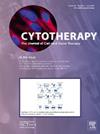Harnessing global HLA data for enhanced patient matching in iPSC haplobanks
IF 3.7
3区 医学
Q2 BIOTECHNOLOGY & APPLIED MICROBIOLOGY
引用次数: 0
Abstract
Background
Several countries have either developed or are developing national induced pluripotent stem cell (iPSC) banks of cell lines derived from donors with HLA homozygous genotypes (two identical haplotypes) prevalent in their local populations to provide immune matched tissues and cells to support regenerative medicine therapies. This ‘haplobank’ approach relies on knowledge of the HLA genotypes of the population to identify the most beneficial haplotypes for patient coverage, and ultimately identify donors or cord blood units carrying two copies of the target haplotype.
Aims
A potentially more efficient alternative to a national bank approach is to assess the haplotypes required to provide global patient coverage and to produce a single, global haplobank. Toward that end, we have developed an algorithm to prioritize HLA haplotypes that optimize coverage across the global population.
Methods
We analyzed data from eighteen countries participating in the Global Alliance for iPS Therapy (GAiT). A representative pool of HLA genotypes, reflecting the HLA of patients, was derived by sampling from each country's WMDA hematopoietic stem cell donor registry, or surrogate population. An algorithm was created based on HLA-A, -B and -DRB1 haplotype homozygous types with population HLA matching coverage defined by the absence of Host versus Graft (HvG) mismatches at these loci. HLA matching coverage was determined by iteratively selecting HLA haplotypes that provide the largest coverage against patient HLA genotypes sampled from the same population, excluding genotypes compatible with previous iterations.
Results
The top 10 haplotypes for each of the 18 countries were identified with patient coverage ranging from 19.5% in Brazil to 63.8% in Japan, with a mean coverage of 33.3%. In a ‘global’ model, utilizing the 180 most frequent haplotypes across all 18 populations (equivalent to 10 lines per country), the patient coverage ranged from 54.6% in India to 81.7% in Sweden, with a mean of 68.4%. Our findings demonstrate that global collaboration could more than double the potential for patient HLA matching coverage.
Conclusions
Interrogation of unrelated hematopoietic stem cell donor registry and cord blood bank HLA data demonstrated that HLA-A, -B, and -DRB1 homozygous donors for the top 180 global haplotypes are widely available. These results show that a globally coordinated strategy for haplobanking would reduce redundancy and allow more patients to be treated with the same investment.
利用全球HLA数据增强iPSC单基因库的患者匹配。
背景:一些国家已经开发或正在开发国家诱导多能干细胞(iPSC)库,这些细胞系来源于当地人群中普遍存在的HLA纯合基因型(两种相同的单倍型)的供体,以提供免疫匹配的组织和细胞来支持再生医学治疗。这种“单倍库”方法依赖于对人群HLA基因型的了解,以确定患者覆盖范围内最有益的单倍型,并最终确定携带两个目标单倍型拷贝的供体或脐带血单位。目的:一种可能比国家银行方法更有效的替代方法是评估提供全球患者覆盖所需的单倍型,并产生一个单一的全球单倍型银行。为此,我们开发了一种算法来优先考虑HLA单倍型,以优化全球人口的覆盖率。方法:我们分析了参与全球iPS治疗联盟(步态)的18个国家的数据。HLA基因型的代表性池,反映了患者的HLA,是通过抽样从每个国家的WMDA造血干细胞供体登记,或替代人群。基于HLA- a, -B和-DRB1单倍型纯合型,通过在这些位点不存在宿主对移植物(HvG)错配来定义群体HLA匹配覆盖率,创建了一种算法。HLA匹配覆盖率是通过迭代选择HLA单倍型来确定的,这些单倍型对同一人群中采样的患者HLA基因型提供最大的覆盖率,不包括与先前迭代相容的基因型。结果:18个国家的前10个单倍型被确定,患者覆盖率从巴西的19.5%到日本的63.8%不等,平均覆盖率为33.3%。在一个“全球”模型中,利用所有18个人群中180个最常见的单倍型(相当于每个国家10个系),患者覆盖率从印度的54.6%到瑞典的81.7%不等,平均为68.4%。我们的研究结果表明,全球合作可以使患者HLA匹配覆盖率增加一倍以上。结论:对不相关造血干细胞供体登记和脐带血库HLA数据的调查表明,全球前180个单倍型的HLA- a、-B和-DRB1纯合供体是广泛可用的。这些结果表明,单基因银行的全球协调策略将减少冗余,并允许更多的患者接受相同的投资。
本文章由计算机程序翻译,如有差异,请以英文原文为准。
求助全文
约1分钟内获得全文
求助全文
来源期刊

Cytotherapy
医学-生物工程与应用微生物
CiteScore
6.30
自引率
4.40%
发文量
683
审稿时长
49 days
期刊介绍:
The journal brings readers the latest developments in the fast moving field of cellular therapy in man. This includes cell therapy for cancer, immune disorders, inherited diseases, tissue repair and regenerative medicine. The journal covers the science, translational development and treatment with variety of cell types including hematopoietic stem cells, immune cells (dendritic cells, NK, cells, T cells, antigen presenting cells) mesenchymal stromal cells, adipose cells, nerve, muscle, vascular and endothelial cells, and induced pluripotential stem cells. We also welcome manuscripts on subcellular derivatives such as exosomes. A specific focus is on translational research that brings cell therapy to the clinic. Cytotherapy publishes original papers, reviews, position papers editorials, commentaries and letters to the editor. We welcome "Protocols in Cytotherapy" bringing standard operating procedure for production specific cell types for clinical use within the reach of the readership.
 求助内容:
求助内容: 应助结果提醒方式:
应助结果提醒方式:


